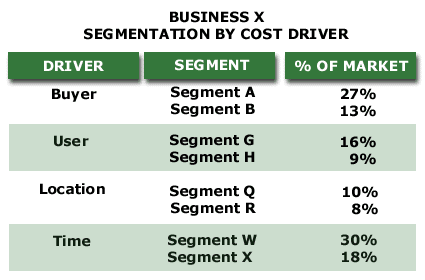Analysis 3: Segmentation By Cost Driver
EXHIBITS:

| EXPLANATION OF THE EXHIBIT: In this hypothetical illustration, the company's brainstorming sessions have produced eight potential new segments in the market: two segments each in the cost drivers of Buyer, User, Location and Time. The brainstorming exercise estimates that Segment A, one of the two segments in Buyer Characteristics, represents 27% of the market. Segment G, one of the two segments in User Characteristics, represents 16% of the market. Any segment with 5% or more of the market is probably worth pursuing. Product and service innovations and pricing schemes for that size of segment would have a significant potential customer base.
PURPOSE: This analysis defines the major need segments of customers in the marketplace and estimates the percentage of the total market each need segment represents. Each of these needs can be better met than they are currently and the meeting of theses needs would have a significant impact on company costs. APPROACH: To complete this analysis, the company brainstorms, using various categories of each potential segmentation. For example, with Buyer Characteristics, the company's Marketing and Sales staff would brainstorm potential market segments that differ from one another along such characteristics as knowledge about the company, quality and so forth. The cost driver segmentations focus on those needs of customers that competitors in the marketplace could fill better than they are filling today. A need that is already being filled offers the company no opportunity to gain volume. However, a need that is being partially filled offers the company an opportunity to improve the fulfillment of the customer’s needs and to gain volume on that innovation. Once the company has listed the current or potential segments in the marketplace, it should make a rough estimate of the size of each segment, in percentage of unit purchases in the market. These estimates help the company quantify the payoffs from innovations in performance or from cost reduction programs. For a brainstorming approach to uncover segments, see Analysis 4: Segmentation By Cost Driver Brainstorming Exercise. |
|
Recommended Reading |
| For a greater overall perspective on this subject, we recommend the following related items:
Analyses: Symptoms and Implications: Symptoms developing in the market that would suggest the need for this analysis.
Perspectives: Conclusions we have reached as a result of our long-term study and observations.
|
